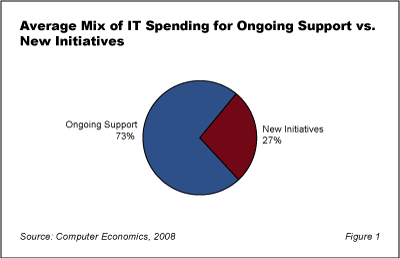In periods of economic growth, businesses focus less on restraining costs and more on making investments to capture new business. This was no more evident than in our annual Computer Economics survey last year in which “developing new systems” rose to the No. 1 priority. But inevitably those priorities shift, and shift quickly, as the business cycle turns. In today’s climate of slowing economic growth, IT managers need to be ready to defend the efficiency of their ongoing operations against pressure to make cutbacks while sustaining investment in high-priority strategic initiatives.
This often means keeping a good handle on just how much it costs (or should cost) the IT group to “keep the lights on.” Tracking the ratio of ongoing IT support costs to new-initiative spending can be critical for maintaining a proper level of investment in IT infrastructure.
This Research Byte is a summary of our full report, IT Spending For New Initiatives: Key Measure of Efficiency, Competitiveness.
The term “new-initiative spending” is admittedly vague, and organizations vary widely in what they classify as such. We define the term as spending on projects that introduce new technology or capabilities that increase the value of IT to the business. That could include rolling out new ERP, business intelligence, or Web 2.0 applications. It could also include spending on applications consolidation, server virtualization, and other infrastructure initiatives designed mainly to improve operational efficiencies.
The remainder, which we call “spending for ongoing support,” includes all spending needed to support existing business systems, including spending on routine hardware replacement and software upgrades, bug fixes, software maintenance, personnel, facilities, and the like. It would also include non-discretionary spending required to comply with regulations or to support normal growth of the business, such as growth in business volume or number of users. In other words, ongoing support is everything that the IT organization must do to continue to support the business in the same ways it does today.
The study is based on interviews with IT executives and a survey conducted in October and November 2007 on IT budgeting. The study analyzes responses from 112 IT executives representing companies with annual sales between $30 million and $100 billion. Forty-five percent of our respondents are from large companies with more than $750 million in revenue, 25% represent midsize companies with $250 million-$750 million, and 30% work in small companies with less than $250 million in revenue.
The Benchmark for Spending on New Initiatives
Over the last few years, business and governmental organizations of all sizes have been giving priority to spending for new initiatives. Our survey indicates that new-initiative spending remained strong throughout 2007. Respondents in the survey reported spending, on average, 27% of their IT budgets on new initiatives, as shown in Figure 1. Surprisingly, the survey showed very little difference in average spending on new initiatives as a percentage of total IT budget among small, midsize, and large organizations. In other words, the 27% average ratio appears to be fairly consistent, regardless of organization size.

The full version of this report looks at the percentage of the IT budget currently allocated to new initiatives, establishes a benchmark for an appropriate ratio of spending on new initiatives versus ongoing support, assesses current practices on tracking new-initiative spending, and discusses advantages for establishing systems to track this important ratio.
Computer Economics Viewpoint
Interviews with CIOs who participated in the study suggest that more and more companies are moving toward tracking this ratio, so we expect the percentage of companies doing so to rise in future surveys. There are a number of strong reasons for tracking new-initiative spending versus ongoing-support spending:
- It improves efficiency. There is a tendency to forget about what you have been paying for year after year. Last year, CIO Doug Bond of Century Insurance Group put systems in place to track spending on ongoing support and found that it focused attention on reducing expenses. “On an ongoing basis we’re continuing to monitor it to make sure that the ratio is dropping,” he says.
- It demonstrates the value of IT. Identifying spending on new initiatives demonstrates to the CEO and other top managers what IT is bringing to the table as it requests new funding. “It sells IT as a value-add,” says Michael Crowley, former CIO of C&D Technologies, now principal of Michael Crowley Consulting LLC.
- It helps set budget priorities. A new-initiatives budget enables top executives to set priorities for spending from among competing investments being advanced by various business units. “It’s easier to get the right priorities,” says Bob Dulski, director of information services for the Chicago Zoological Society.
- It promotes infrastructure investment. IT managers can more easily demonstrate gains in efficiency and sell budget approvals for critical infrastructure investments by demonstrating ROI. Being able to show how IT spending has risen as a result of business growth or last year’s new initiatives also helps decision-makers focus on spending that is discretionary.
The ultimate goal of tracking this key ratio is to improve the spending mix and free up more money for innovation and infrastructure reinvestment. In today’s climate, IT managers need to be prepared to constantly glean efficiencies from their “keep-the-lights-on” budgets in order to fund innovation. The conundrum is that a company that fails to reinvest in its infrastructure will become less efficient, and an inefficient operation will not be able to sustain investment in innovation. It is a downward spiral that has the long-term consequence of becoming increasingly uncompetitive.
This Research Byte is a brief overview of our report on this subject, IT Spending For New Initiatives: Key Measure of Efficiency, Competitiveness. The full report is available at no charge for Computer Economics clients, or it may be purchased by non-clients directly from our website at https://avasant.com/report/it-spending-for-new-initiatives-key-measure-of-efficiency-competitiveness-2008/ (click for pricing).

